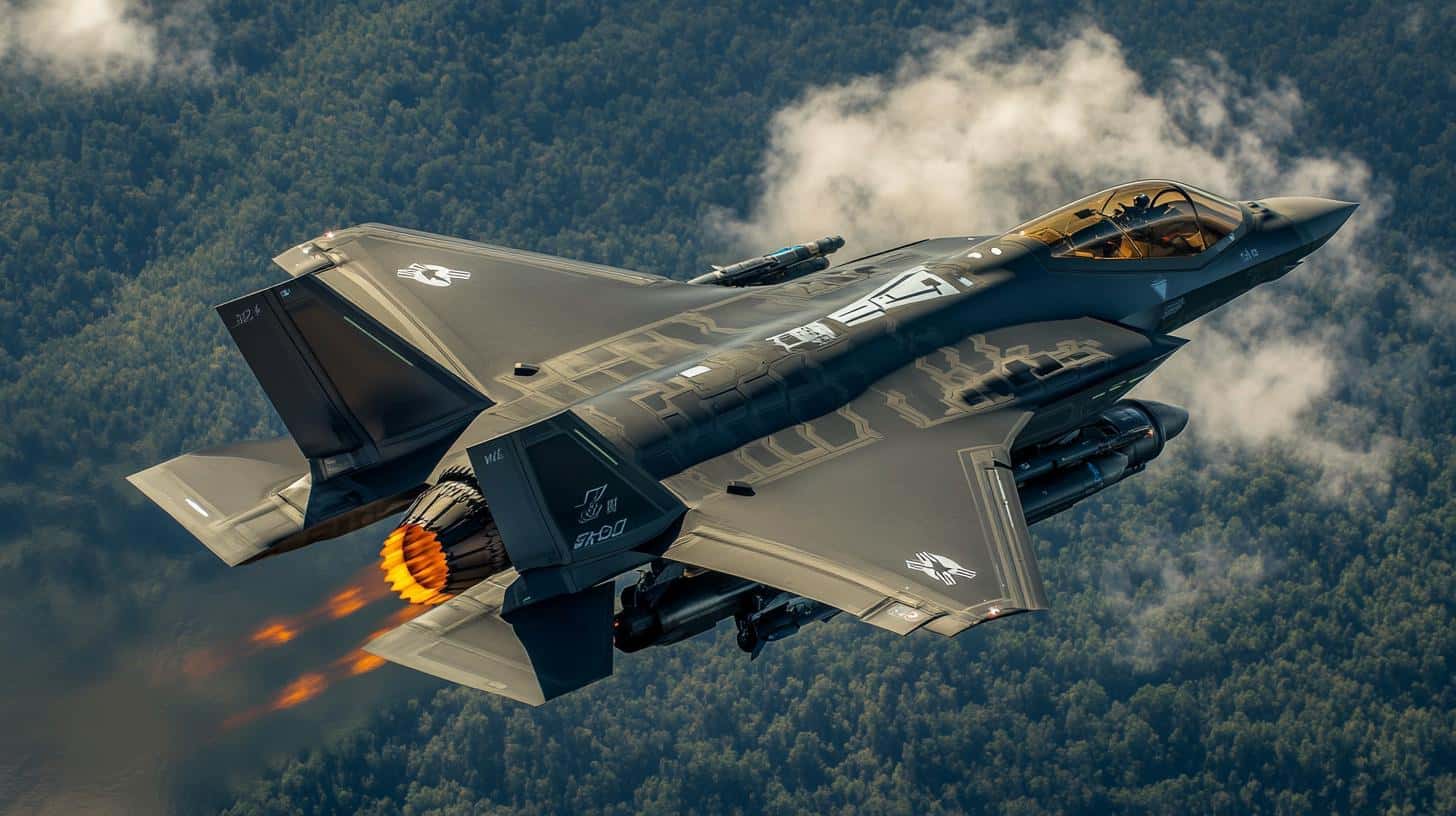In the high-stakes arena of global defense, military aviation innovation is relentless. Among these advancements, Lockheed Martin’s F-35 Lightning II stands as a monument to cutting-edge technology, thrusting forward with a new initiative in engine development that could redefine modern air combat. While its history is deeply rooted in ground-breaking stealth and versatility, the F-35 is now poised to reach new heights with significant enhancements in its propulsion system.
Transforming Thrust into Triumph
As the heart of the F-35, the Pratt & Whitney F135 engine has driven the aircraft’s dominance across various theaters of operation. However, recent strides in aerospace engineering paved the way for an iteration of this power plant, refocusing on increased output and efficiency. The next-generation engine initiative is designed not only to improve existing capabilities but also to respond to evolving military demands.
Among the most promising advancements is an impressive improvement in fuel efficiency. This enhancement isn’t just about cost savings; it’s an operational advantage that extends mission endurance and boosts strategic reach. This focus aligns with a broader military emphasis on sustainability, where reduced fuel consumption equates to minimized logistical footprints in conflict zones.
Stealth: The Invisible Shield
The F-35’s journey through the skies has always been cloaked with signature stealth technology. The upcoming engine revisions offer innovations that continue this tradition by employing advanced materials and engineering solutions to further suppress thermal and acoustic emissions. Such enhancements are pivotal in outmaneuvering sophisticated enemy radar systems, thus strengthening the F-35’s place in air superiority tactics.
The Race Against Time
Behind this propulsion revolution is a meticulously planned timeline, with rigorous testing and production phases ensuring every component meets the highest standards. This commitment reflects not just on the United States military forces, but extends to bolster NATO and allied defense capabilities worldwide, exemplifying global cooperation in defense endeavors.
Integration of this new technology into operational fleets is closely watched, as its success is anticipated to fortify the F-35’s stature as a keystone in aerial defense strategy—ensuring it can tackle any threat landscapes of the future head-on.
Aviation’s Evolution Continues
As warfields transform, the demands on combat aircraft become more intense, ushering in an era where the F-35 is not only a tool of defense but a facilitator of aerial innovation. This poised upgrade exemplifies how rigorous research and development can transcend existing boundaries, offering an aviation marvel ready for the modern complexities of warfare.
For enthusiasts and defense observers, the unfolding narrative of the F-35’s propulsion system is one of technological triumph and ongoing evolution, witnessing the intersection where engineering ingenuity meets strategic necessity, crafting a fighter that remains unparalleled in its class.
Top Tips to Understand the Future of Military Aviation Innovation
In the dynamic world of military aviation, keeping pace with technological advancements is crucial for defense enthusiasts and industry professionals alike. The article on Lockheed Martin’s F-35 Lightning II highlighted its groundbreaking propulsion system improvements, emphasizing engine efficiency, stealth, and operational strategy. Here, we offer additional insights and tips to deepen your understanding of this complex domain and suggest resources for further exploration.
1. Understanding Engine Efficiency
When discussing advancements in engine technology, it’s important to recognize the key areas of improvement. For example, increased fuel efficiency not only reduces operational costs but also extends mission durations. Stay informed about the latest developments in aerospace engineering that focus on enhancing these aspects. For a broader understanding of aviation history and technology, you can explore Lockheed Martin, a major player in aerospace and defense.
2. The Importance of Stealth Technology
Stealth capability is a crucial element of modern military aircraft, allowing them to operate undetected by enemy radar. Advancements in materials and design aim to minimize acoustic and thermal emissions. Understanding these technologies can help appreciate how aircraft maintain an edge in air superiority. For more detailed information on stealth systems, check out resources from Northrop Grumman, known for their contributions to stealth technology.
3. Exploring Testing and Production
The rigorous testing and production phases are integral to the successful deployment of new technologies in military aviation. These processes ensure that every aspect of the aircraft meets stringent standards. To gain insights into how such testing influences aircraft development, follow updates from leading aerospace firms. Companies like Boeing offer a glimpse into the intricacies of aircraft production and testing.
4. Global Cooperation in Defense
The integration of new technologies like next-generation engines often involves international collaboration, enhancing defense capabilities among allied nations. Understanding these cooperative efforts provides context to how global defense strategies are shaped. Consider exploring the initiatives of defense alliances such as NATO to see how they incorporate cutting-edge technology in their forces.
5. Keeping Up with Aviation News
Stay updated with the latest developments in aviation technology through reliable defense news platforms. This will not only keep you informed about aircraft like the F-35 but also about broader industry trends and technological innovations. Websites like Defense News provide comprehensive coverage of the global defense landscape.
As military aviation continues to evolve, it’s important to keep learning and exploring. By leveraging these tips and resources, you can gain a deeper understanding of the forces shaping the future of aerial defense and ensure that you remain at the forefront of this rapidly advancing field.
The article has been updated: 2024-11-07 07:14
Here are some suggested related links for your post titled “Pioneering Propulsion: The Future of Combat Aviation with the F-35’s New Engine”:
1. Lockheed Martin – The official website of Lockheed Martin, the manufacturer of the F-35 fighter jet, featuring information on aircraft technology and innovation.
2. Northrop Grumman – A major defense contractor involved in advanced aerospace and defense technologies, including propulsion systems.
3. Boeing – Visit Boeing’s official site to learn about their role in aerospace and defense, including cutting-edge aircraft design and engine technology.
4. U.S. Department of Defense – The official site for the U.S. military, providing information on defense policies, programs, and procurement, including updates on combat aviation.
5. Aerospace Talk – A platform that discusses the latest trends in aerospace technology, including engine advancements and their implications for combat aviation.
6. Janes – Renowned for defense and security intelligence, Janes provides in-depth analysis on military jets, engines, and defense technology innovations.
7. Air Force Magazine – The official magazine of the Air Force Association, which covers news, analysis, and insights into modern aviation and fighter jet developments.
8. Defense News – A news source focused on military and defense issues, including coverage of aircraft technology and future combat aviation strategies.
9. The Drive – A publication that covers the latest in military and civilian aircraft developments, including innovations in propulsion systems.
10. FlightGlobal – A leading aviation news website that provides insights, analysis, and updates on commercial and military aviation, including engine developments.
The article has been updated: 2024-11-07 21:42
What advancements does the new engine for the F-35 bring to the future of combat aviation?
The new engine for the F-35, known as the F135, introduces several significant advancements that enhance combat aviation capabilities. Key improvements include increased thrust and fuel efficiency, which allow for faster speeds and longer missions without the need for frequent refueling. Additionally, the new engine features advanced stealth technologies that reduce its radar signature, making it harder for adversaries to detect. The integration of improved thermal management systems also helps in optimizing performance during high-stress combat situations. These innovations not only improve the F-35’s operational effectiveness but also position it as a pivotal player in future aerial warfare.







